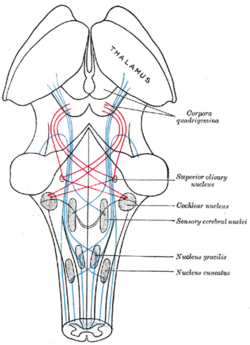From Wikipedia, the free encyclopedia
| Scheme showing the course of the fibers of the lemniscus; medial lemniscus in blue, lateral in red. | ||
| Latin | thalamus dorsalis | |
| Gray's | subject #189 808 | |
| NeuroNames | hier-283 | |
| MeSH | Thalamus | |
The thalamus (from Greek θάλαμος = room, chamber, IPA= /ˈθæləməs/) is a pair and symmetric part of the brain. It constitutes the main part of the diencephalon.
Function
The thalamus is known to have multiple functions. Deduced from the design of the isothalamus, it is generally believed to act as a translator for which various "prethalamic" inputs are processed into a form readable by the cerebral cortex. The thalamus is believed to both process and relay sensory information selectively to various parts of the cerebral cortex, as one thalamic point may reach one or several regions in the cortex.
The thalamus also plays an important role in regulating states of sleep and wakefulness.[4] Thalamic nuclei have strong reciprocal connections with the cerebral cortex, forming thalamo-cortico-thalamic circuits that are believed to be involved with consciousness. The thalamus plays a major role in regulating arousal, the level of awareness, and activity. Damage to the thalamus can lead to permanent coma.
Many different functions are linked to the system to which thalamic parts belong. This is at first the case for sensory systems (which excepts the olfactory function) auditory, somatic, visceral, gustatory and visual systems where localised lesions provoke particular sensory deficits. A major role of the thalamus is devoted to "motor" systems. This has been and continues to be a subject of interest for investigators. VIm, the relay of cerebellar afferences, is the target of stereotactians particularly for the improvement of tremor. The role of the thalamus in the more anterior pallidal and nigral territories in the basal ganglia system disturbances is recognized but still poorly known. The contribution of the thalamus to vestibular or to tectal functions is almost ignored. The thalamus has been thought of as a "relay" that simply forwards signals to the cerebral cortex. Newer research suggests that thalamic function is more complicated.[5]


No comments:
Post a Comment